Conceptual artist Ryan Cosbert’s solo exhibition The Past Is The Future And The Future Is Now at UTA Artist Space in Atlanta acknowledges the simultaneity of time. In other words, that the “past,” “present,” and “future” are not discrete points but rather temporal layers that fundamentally inform one another.
The artist’s outlook is evocative of the Ghanian spirit of Sankofa, which is associated with a Bono Adinkra symbol of a bird arching its head back to unearth a seed from the space behind its feathered bust. Most simply, the symbol nods to the importance of reckoning with or retrieving the past in order to construct a livable future, fit with systems, structures, and ideologies capable of unrelentingly caring for all living beings. For Cosbert, such retrieval and construction occurs through a rigorous research process, which she then translates into abstract forms meant to support audiences in grappling with the inheritance of existential loss. Ultimately, the artist believes that cultivating knowledge about our origins is a key spoke in the wheel of individual and collective spiritual development and regards her work as a means of facilitating and contributing to such cultivation.
Below, we discuss Cosbert’s artistic origins, the intricacies of her research process, the historical and political phenomena she probed for this exhibition in particular, and her anti-categorical approach to making that transgresses formal lines between painting and sculpture.
Camille Bacon: I’m curious about how your solo exhibition The Past Is The Future and The Future is Now reflects your research process. What topics are you interested in?
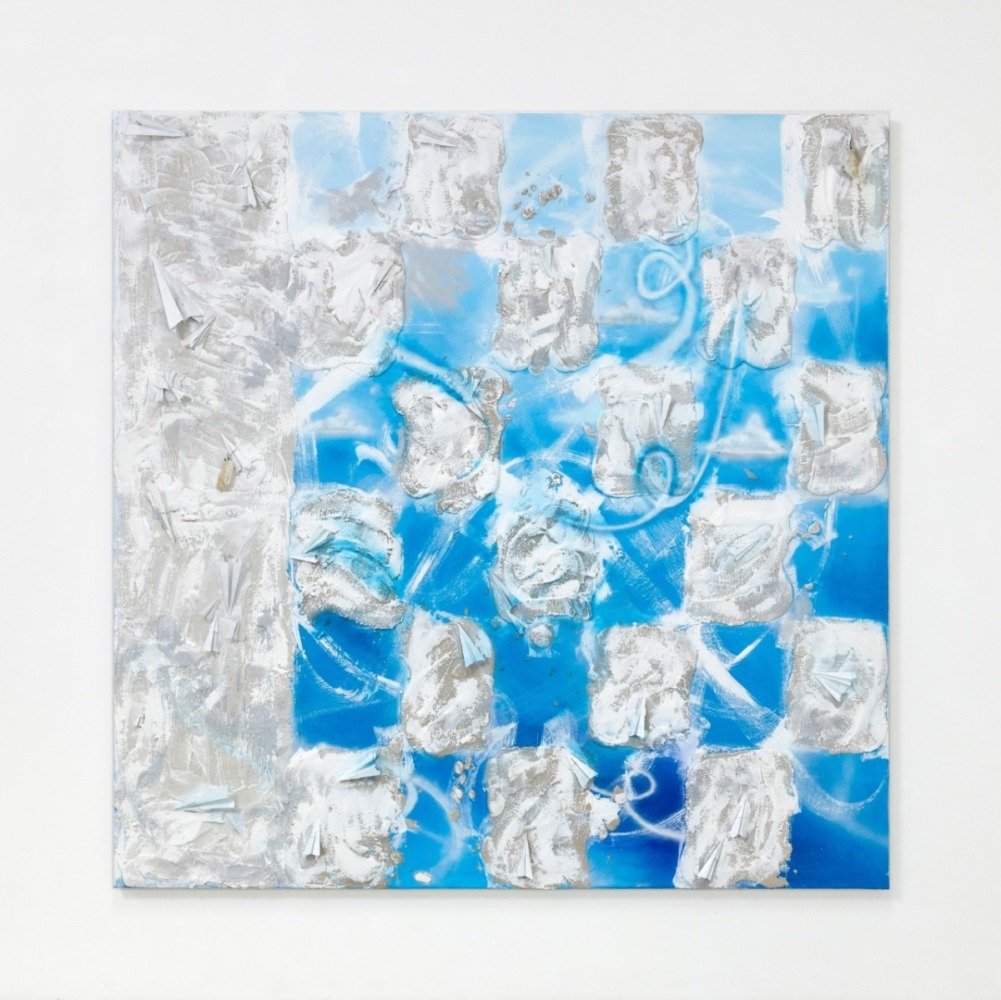
Ryan Cosbert: With this new body of work, I wanted to revisit some of the topics that I lightly covered before that I felt didn’t get enough recognition. So for this solo exhibition, I paired the old research I conducted for my past group exhibitions with what I’m currently working on.
In terms of revisiting old research, I wanted to learn more about Musgum mud huts, which I’ve been reading about for a while. I found out new information and felt like since I already addressed it a bit, it was only right for me to add the new information that I found to the works at UTA. The show features the first Musgum painting I ever made and I made a new one to show how my technique and process has evolved.
For this exhibition, I also conducted new research on epigenetics, which is the transfer of trauma through DNA. When I first started reading about the topic, I was looking at studies from around 2017 that stated that the farthest transfer of trauma was seven generations. Lately though, new studies have revealed that the transfer of trauma can continue for up to 15 generations. We’re currently only in the seventh generation.
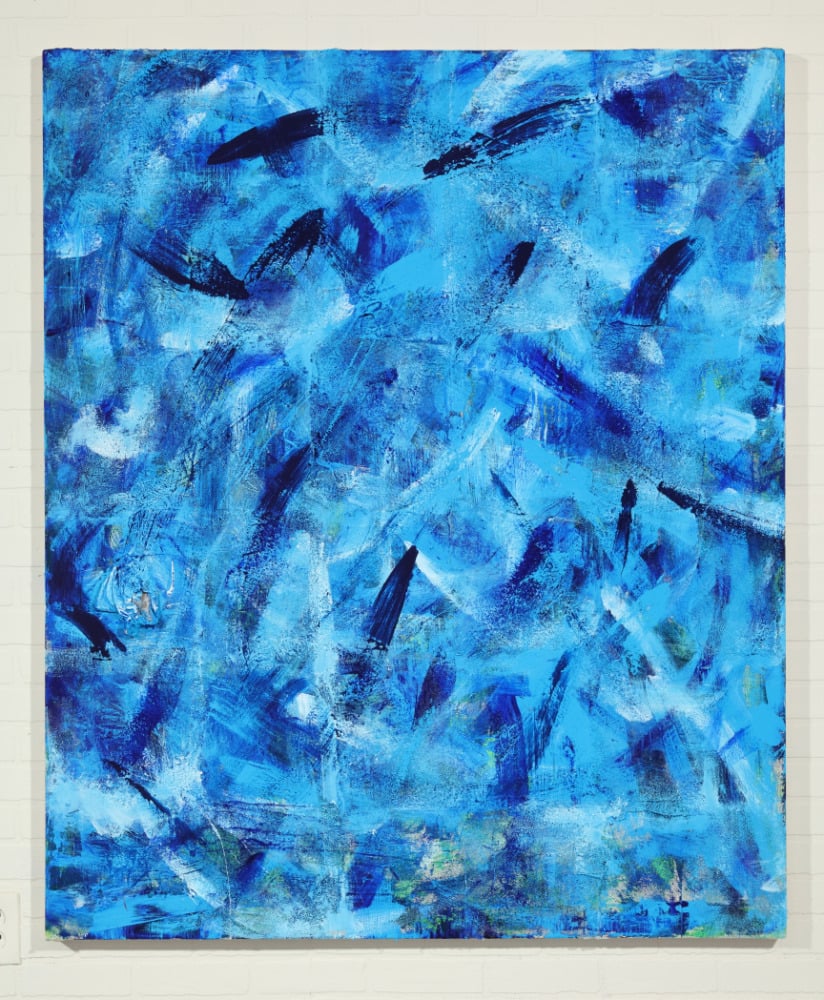
CB: The exhibition features a work called An Ode to Eliza Ann Grier. What was the research process like for this work in particular?
RC: When I knew I was going to do something in Atlanta, I wanted to make an ode to somebody who had roots in the city. I knew that I wanted to cover somebody in the medical industry; it just so happened to be that Grier was the first Black woman to get a license to practice medicine in Atlanta. Concurrent to learning about Grier, I was doing research on the medical industry more broadly and how it has mistreated Black women for centuries. As soon as I found out about Grier, I felt I had to make an ode to her legacy.
CB: In the past you have spoken about how you are interested in imbuing your artworks with codes that usher towards a higher consciousness and spiritual development. I wonder why that is important to you and how you accomplish it?
RC: When it comes to embodying a higher consciousness and spiritual uplift, my main goal is to enlighten people. When I first started doing my research, before I started connecting it to my abstract work, I was originally doing it to help my loved ones, who I noticed did not know much about the African diaspora due to the lack of information in schooling. I noticed sharing information I was learning really helped them navigate the various situations going on in their lives. Then I was like, okay, if I’m sharing this with people close to me and it’s helping, I should definitely share this with as many people as I can.
I think sharing information about topics like epigenetics, for example, is the best way I can help people with spiritual development because giving people the information allows them to learn more about themselves and understand their place in larger historical and political continuums.
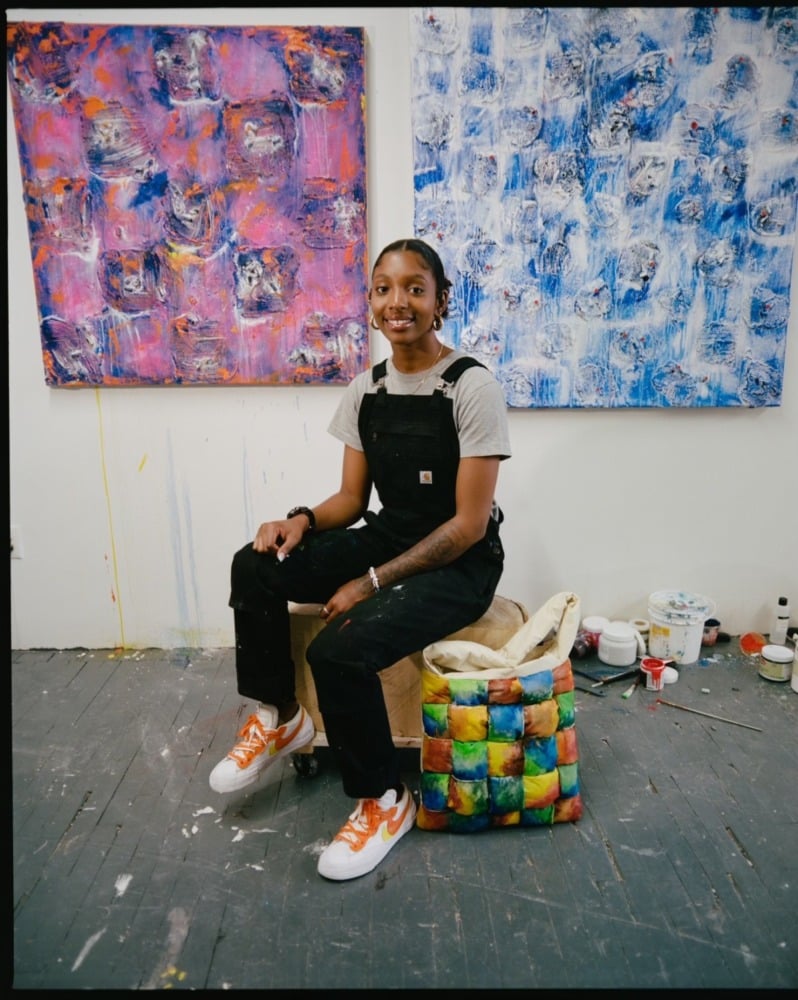
CB: Is it safe to say you regard access to knowledge about our origins, the places our ancestors have been, and the legacies we inherit as a way to tap into a higher consciousness?
RC: Yes, exactly.
CB: I know in the past, you’ve looked to artists like Sam Gilliam and McArthur Binion as major influences. Were there new influences for this body of work and also, which art historical periods or movements served as reference points?
RC: I keep looking at the same artists but I’ve been going to different shows. As I’m traveling, I get to see different bodies of work or different pieces I’ve never seen before. Mainly I’ve been looking at McArthur Binion and Sam Gilliam, like you said, but also Jack Whitten, Frank Bowling, Terry Adkins, Leonardo Drew, Alma Thomas, and Pat Stier. Newly, I’ve been looking at Rashid Johnson. In terms of art movements, I think I’ve been stuck on these two art movements for the past three years: abstract expressionism and conceptual art. Something I started looking at this year was actually mid-century modern furniture, which really helped me with the sculptural aspects of my practice.
CB: Can you tell me more about how a design movement, like mid-century modern, would make its way into the kind of abstractions you make?
RC: I was really fascinated by the silhouettes of the chairs, the tables, and even the lamps. I was also looking at some of the manufacturing and how these items were made and it gave me a different approach to the paintings. I always thought of the paintings as sculpture, but researching and looking at objects from a design movement allowed me to create an entirely new process in terms of how I apply the paint. I even made a new formula for my mixture so that it’s easier for me to use it more like clay to sculpt it onto the canvas.
CB: Can you tell me more about the origins of your tile method, which you use to compose your artworks and perhaps also speak more specifically about how your research into design offered new insights to alter the formula of your mixture?
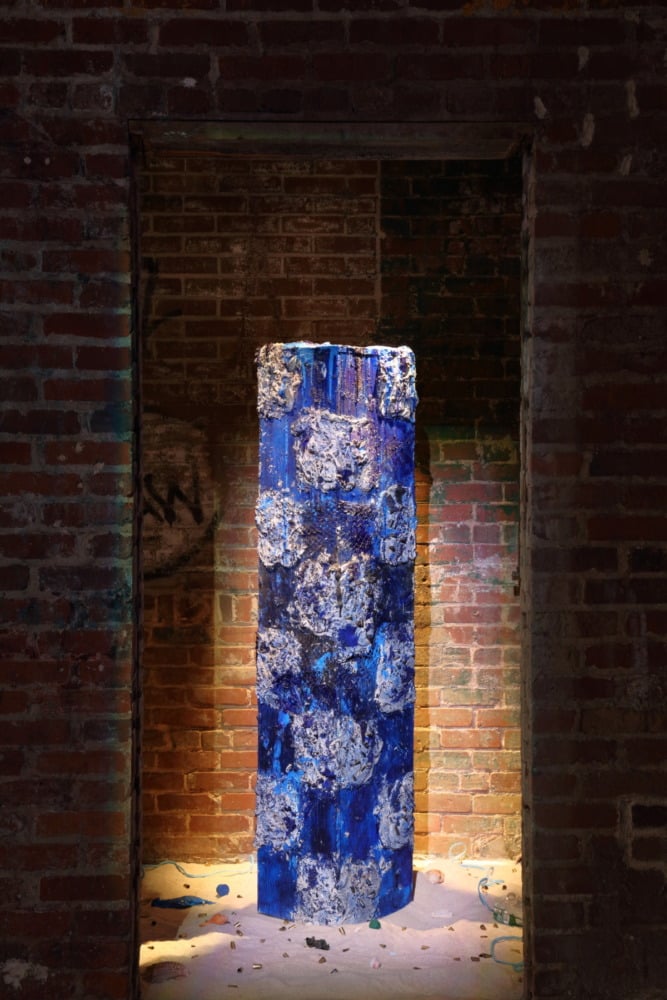
RC: The inspiration for the tiles originally came from my childhood home. My mom had tiles all over the kitchen and the floor and it was always in a specific perfect pattern that was symmetrically aligned all throughout the space. Originally, when I was practicing with my abstract paintings, I had actually drawn a little sketch of the tile method and I had also written down a formula for the mixture. It took me about four months to revisit those notes, which happened after I made several failed paintings. The materials weren’t sticking and I was kind of like, oh man, this isn’t gonna work out. When I went back to my sketchbook, the mixture that I initially wrote down was perfect. It was impossible to get the physical objects I use in the works to come off of the canvas with the new mixture, which was the goal.
CB: Earlier you mentioned thinking about the paintings as sculptures; I’d love to hear more about that.
RC: When I first presented the so-called paintings, I was in my senior year of undergrad at The School for The Visual Arts in New York. I proposed the works as being a thin line in between painting and sculpture. When I started presenting the paintings in person, that complexity got overlooked. With this new body of work, I decided to finally present my traditional sculptures to get people to look at them and realize how they weren’t too far from the paintings. The funny thing is, the sculptures that I presented contain the same exact materials as the paintings. We can consider the paintings to be sculptures in a way, and I’m hoping that framing sticks.
CB: I think that sort of aesthetic mischief pokes holes in someone like Clement Greenberg’s rigid approach to understanding painting as that which goes on the wall and sculptures as that which go on a pedestal. It seems like you are drawing attention to how unhelpful most modes of art historical classification are.
RC: Yeah, the two masks I presented at UTA are exhibited on the wall, but nobody ever called them paintings. They have actual paint on them too.
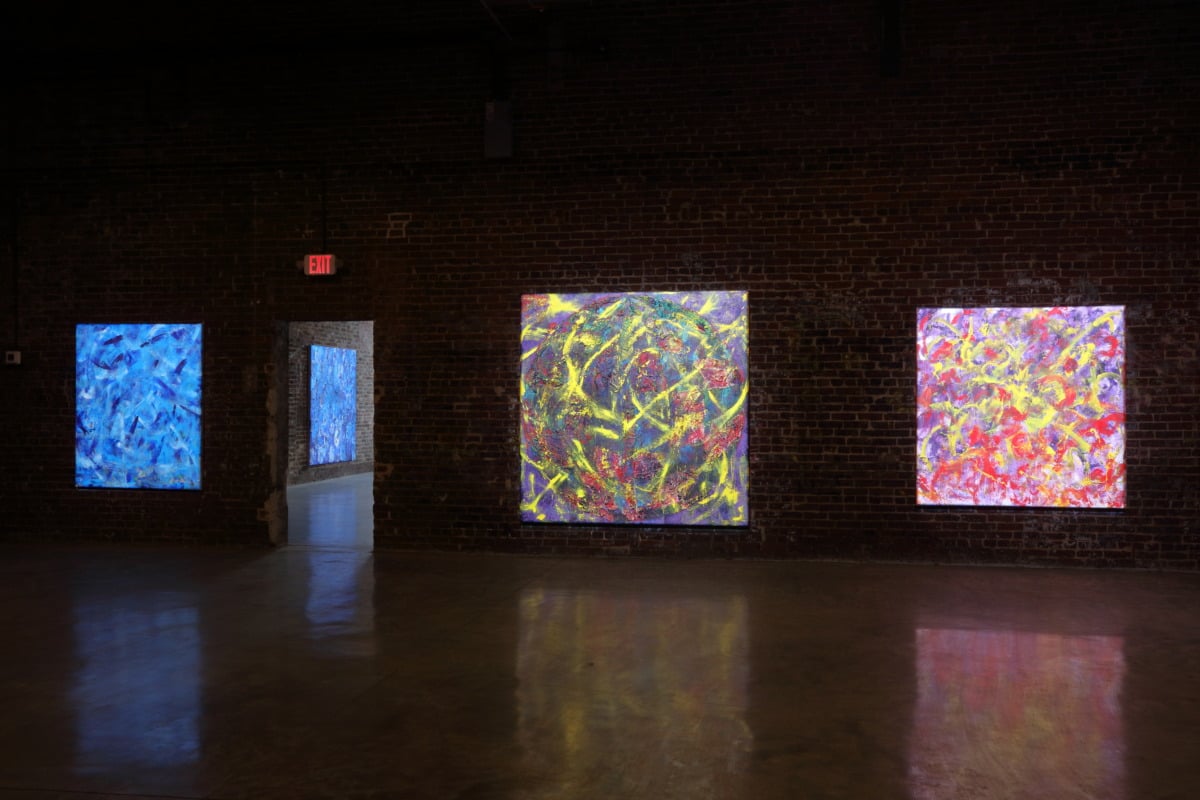
CB: The lighting throughout UTA’s space is quite dim, which marks a notable contrast to the laboratory-esque lighting in most exhibition spaces. The lighting at UTA reminded me of a cathedral of sorts and how, when the light shines through the stained glass windows just right, it feels triumphant and revelatory in a really specific way. I wonder if you could tell me a little bit about darkening the room. Was that intentional?
RC: It actually wasn’t intentional. The funny thing is, I’ve been wanting to exhibit my work on a black wall so the light shines directly onto the paintings, so it ended up working out perfectly and went well with the vision that I already had for the exhibition. Most of the paintings in there have the light projected directly onto them. I think it gives people the chance to see there’s a shadow that projects onto the ground from how the tiles interact with the light. It offers people more of a chance to see that the work is three-dimensional.
Many people lost their lives and we don’t know their names, we don’t have a face. […] With the mask, I guess I’m trying to kind of embody or visualize them and give their spirits a physical presence.
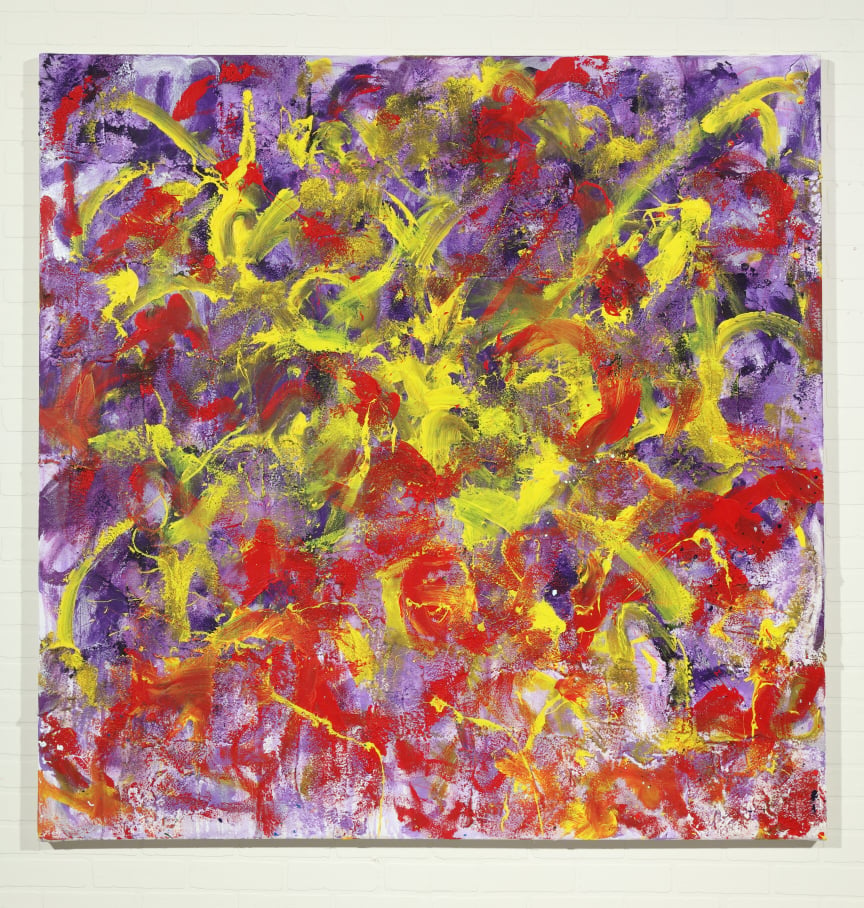
CB: I know that UTA Artist Space very recently started representing you. It’s not a traditional art gallery. I also wonder why it felt productive for you at this point in your career to make that kind of move?
RC: I feel it was the best decision mainly because I’d been working with them prior and I really appreciated how they were handling my work. They were giving me the freedom that other galleries weren’t giving me. They were one of the only places that allowed me to exhibit these sculptures and permitted me to pretty much create whatever I wanted and present them however I want. They didn’t box me in. They never considered me to just be a painter. They actually called me a conceptual artist, so I felt it was a good connection.
CB: Is there anything I’ve neglected to ask you that you’d like to share?
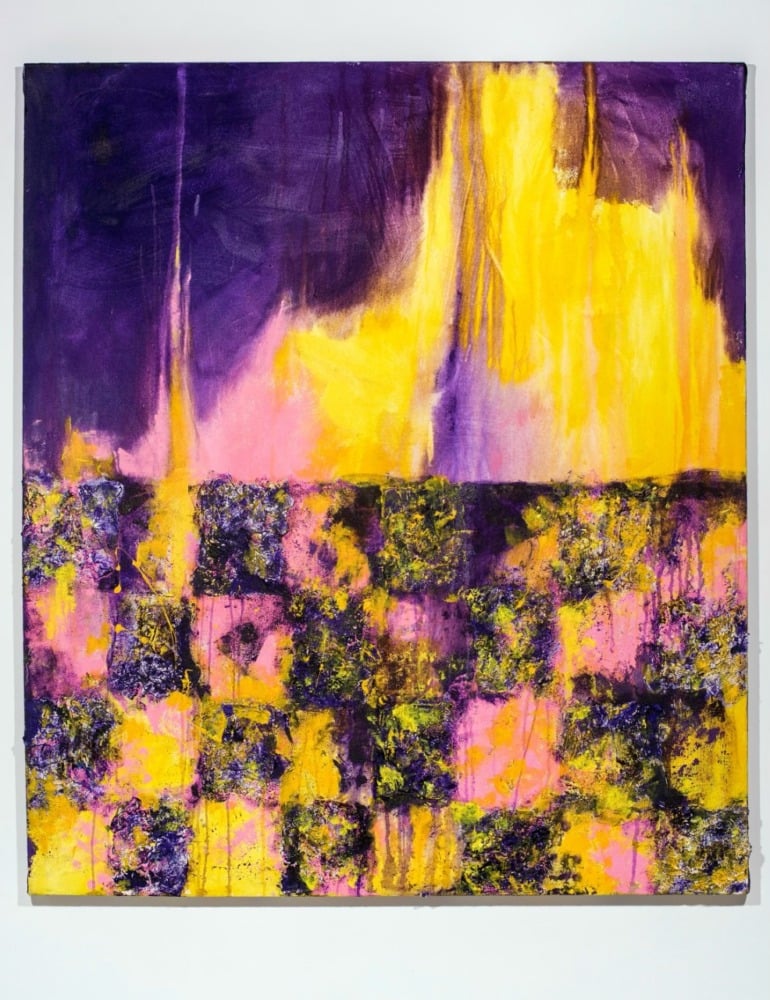
RC: I’d love to talk more about the masks. The one thing that I always end up thinking about every single morning I wake up is the bodies of people who were drowned during the Middle Passage that aren’t documented. Many people lost their lives and we don’t know their names, we don’t have a face. I started to feel like people didn’t really care too much because they didn’t know who they were. With the mask, I guess I’m trying to kind of embody or visualize them and give their spirits a physical presence.
CB: What does it mean to memorialize someone like Grier as well as those lost to the sea throughout the Middle Passage in an abstract form?
RC: I think representing them in an abstract manner gives me the chance to present their essence. When people see the materials in the paintings, and then they see “an ode to” in the title, it gives viewers a chance to ask questions. It allows more curiosity around what the work is about. In a way, it helps me accomplish my goal of enlightening people and providing more content to feed their curiosity and therefore also their spiritual development. During the opening reception for my exhibition, there were so many people who actually pulled out their phones and did research. It was beautiful to see that sort of self-directed curiosity come to life as a result of interacting with my work.
